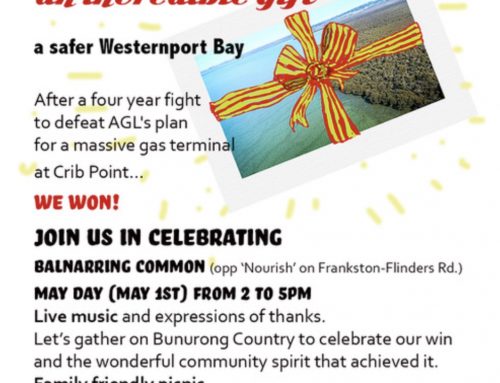One of the most confounding aspects the Crib Point gas import terminal is the very idea of gas import itself. This is especially true considering Australia’s status as a top ranking gas exporter.
The Port of Hastings media release (available here) that introduced the AGL proposal at Crib Point last year is typical of information used to explain the apparent need to import gas. It quoted the Australian Energy Market Operator AEMO report at the time, which predicted shortfalls in the domestic supply of gas:
The Australian Energy Market Operator’s March 2018 Victorian Gas Planning Report highlights a potential shortfall in gas supply during peak gas demand in 2021 and a potential shortfall in total supply in 2022. Remediation work needs to start now so that, should AGL obtain the required project approvals and make the decision to proceed, Berth No.2 is available in time to meet this forecast shortfall.
Because Australia has a ready supply of LNG it is among the top producers of the commodity in the world, and yet the forecast was that there would not be enough to supply our needs in the coming years unless a new source was brought on line.
How did we arrive in this strange predicament?
The reason can be traced back to the high international price of gas. Gas retailers, seeing this as an opportunity, locked Australia into lucrative long term contracts to sell the resource on the overseas market. This suited the energy providers, who made record profits from these sales, and indeed from hiking up the price of gas to local customers as well.
The fact that the arrangement was so profitable led market regulators to continue with their “hands off” strategy, allowing retailers to make up the rules, and make their hay while the sun was shining.
And they did.
Meanwhile Australia became one of the only gas producing countries not to have a domestic reserve, and was soon paying among the highest prices for household supply. The reason companies like AGL were so unconcerned about creating a local shortfall ? Because these circumstances were so profitable for them.
Another reason was the fluctuating international gas market. In order to maximise profit opportunities in response to these fluctuations, an enormous industry shipping gas around the world had grown to supply a new kind of temporary gas processing plant, the FSRU Floating Storage Regasification Unit. This floating gas factory could in theory be moored close to wherever the market supply was needed, without having to go through the strict planning and approvals processes that normally exist when refineries are constructed on land, particularly near populated areas.
AGL knew well that they could further exploit this gas madness, by buying cheap gas from the Northern hemisphere during their summer, when peak demand and prices were in effect during winter in Australia. AGL probably began looking around for the ideal place to park an FSRU years ago, knowing that a shortfall was imminent.
The kind of inept science and missing data typical of their reports for the project gave the impression that they believed that with government backing, they could get the thing operational at minimal cost in time and money.
Consider the following excerpt from August, 2017 in the Mornington Peninsula News:
The government issued a statement on Thursday saying it “welcomed AGL’s decision … [and is] working closely with AGL to ensure approvals processes are streamlined to avoid unnecessary delays.
It’s no wonder AGL believed there was little reason for concern!
Community Response
AGL were not counting on an active and resilient community campaign of information and local opposition. The truth is that as soon as most people came to understand the risks posed by the FSRU, and the irresponsible mismanagement that led to it, their opposition to the proposal was almost guaranteed.
They tried their best to convince community members during “community consultation sessions” that the gap in supply was so pressing, that unless we went ahead with the proposal asap, it was as if we would soon be freezing in our homes. When that tactic didn’t fly, they tried to promise us it would bring “downward pressure on gas prices”.
Though obviously not keen to publicise it (by silently slipping in on their website), AGL had to admit that they cannot predict or guarantee any certainty about prices.
ACCC Finally Acknowledges The Culprit
The surprise recommendation last Friday (October 19th, 2018) by the ACCC that an federal reserve of LNG is required is welcomed because it will ensure that in future, enough of our precious natural resources are available for the benefit of Australians, and not for speculation and sale by corporations whose only responsibility is to their shareholders.
A federal gas reserve will also guarantee that we never face shortfalls that would leave us at the mercy of corporation’s unsafe and environmentally unfriendly ways of importing gas on the cheap . Australians will no longer vulnerable to the tricks of private enterprise for the supply of this essential service, and will hopefully leave the Crib Point Proposal redundant and dead in the water.




